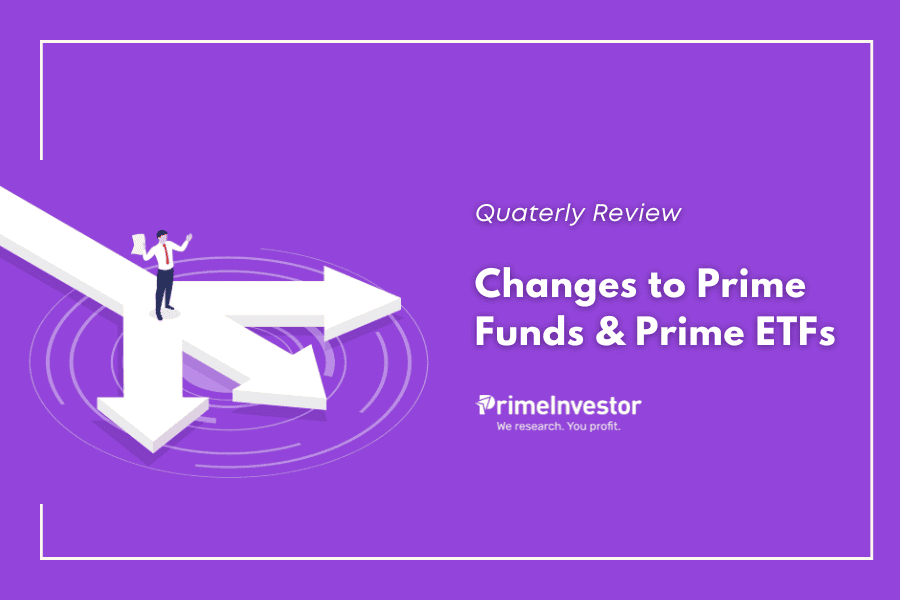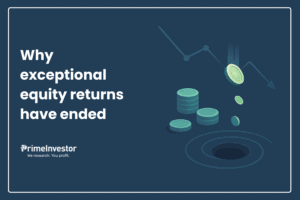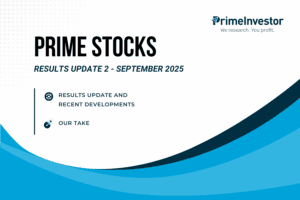Prime Funds is our list of recommendations in equity, debt, and hybrid mutual funds that are worth investing in. Prime Funds narrows down your choices from the thousands of funds that there are into a concise list of funds that span different styles. Prime Funds are selected based on performance, portfolios, and investment strategies.

In this review, we have made changes in multiple Prime Funds categories. Please go through the report in detail to know the changes and the rationale.
About Prime Funds
Prime Funds is our list of best mutual funds across the equity, debt, and hybrid categories. We use Prime Ratings, our fund ratings, as a first filter. We then apply qualitative analysis to arrive at our fund recommendations. Prime Funds is an enduring list of funds that you can use at any time. You will always find a fund to meet any goal you’re looking to meet.
Different categories: Prime Funds are separated into buckets, based on risk level in equity & hybrid funds and timeframe in debt funds. Each of these draws from different SEBI-defined categories. We have classified them in a more user-friendly way than using the several dozens of SEBI categories. We do not go only by Prime Ratings but look at other factors as well to narrow the list and make the choices easy for you.
Different styles: In Prime Funds, we’ve aimed at providing funds that follow different strategies for you to mix styles and diversify your portfolio with ease. The ‘Why this fund’ for each Prime Fund will brief its strategy, why we picked it, and how to use it in your portfolio.
Direct plans: We have specifically given the direct plans in Prime Funds. If you wish to know whether it is ok for you to use the regular plan of the fund, check our Portfolio Review Pro tool periodically to know if you are with expensive regular plans.
Quarterly review: Our aim in reviewing the Prime Funds list every quarter is to ensure that we don’t miss any good opportunities that are coming up and we are not holding on to funds that are slipping. When we remove funds from the Prime Funds list, we tell you exactly what to do if you have invested in these funds. Funds we remove do not immediately call for a sell – it is just that they have slipped in performance marginally or there are better alternatives now. Unless our review tool says such funds are a ‘sell’, you can hold them (refer to our article on when to sell funds)
Using Prime Funds: You don’t need to hold every Prime Fund nor add every new fund we introduce to the list. Unless it fits your overall portfolio/strategy, or there is something lacking, there is little need for you to go on adding funds. Our idea of covering them in detail through some of our calls is to let you know the strategy, style, and suitability in different portfolios. It is not a specific call to buy right away, unless we mention that it is a ‘tactical’ or ‘timing’ call. If you need to build a portfolio using Prime Funds, use our Build Your Own Portfolio tool to make this easy for you.
Equity
The last quarter of 2024 saw the much-awaited correction with the Nifty cracking more than the mid and small-cap indices. Multiple reasons – from FPI pull outs, moderating earnings, slackening GDP growth in the June and September quarters and more – triggered the fall, albeit not a steep one. As always, our equity funds held up well. (Read our performance report of Prime Funds for 2024 for more).
But moving into 2025, it isn’t going to be easier as we carry forward weak earnings and GDP growth. While you will hear from us in a week’s time on our 2025 Equity Outlook, there are a few things you need to follow when it comes to your equity portfolios. They are:
- Do not try to fully exit equities and move into cash. Instead, simply use our Portfolio Review Pro tool to check your present allocation to a fund/asset class and see if it has significantly deviated from your original (or required) allocation. Rebalance if this deviation is high.
- While small and midcap indices have not corrected as much as the large-cap indices, this does not mean you should exit mid and small-cap funds thinking they are over-valued. The above rebalancing activity we mentioned will take away any excess profits in such funds, and still allow you to participate in these high beta categories over the long term.
- Any fresh large lumpsum investments now in diversified equity funds is best done through SIPs. You can start SIPs and in deep corrections, hasten the investment by deploying lumpsums in between, in addition to the SIPs. This means your SIP period will be cut down, which is fine.
Equity funds – moderate – active
We have not made any changes in this category. However, we wanted to highlight the performance of Canara Robeco Flexicap. This had been one of the underperformers in our ‘Moderate’ Prime Funds category, and we had explained both the underperformance and why we continued to have the fund in our earlier quarterly reviews.
Canara Robeco Flexicap has begun to outperform the Nifty 500 index since late October 2024, on a rolling 1-year return basis. It has also been narrowing its margin of underperformance with the category (we have a large set of peers for this rating set where we club multiple SEBI categories as well as broad thematic funds that fit this set. That means the peer set is pretty large here). We will continue to monitor this fund for performance improvement.
Equity funds – aggressive – active
In this set, we have added one more aggressive fund from the midcap space – Nippon India Growth. This fund seeks to follow a growth-at-reasonable-price strategy. It looks for mid-sized companies that hold potential to become leaders across themes such as consumer discretionary, healthcare, financials and outsourcing to global corporations. It holds a very diversified portfolio of 90-100 stocks. It largely follows a buy-and-hold strategy with low portfolio turnover compared with peers in the midcap segment.
The fund outperformed the Midcap 150 index about 85% of the times on a rolling 1-and 3-year return basis (returns rolled daily). Nippon India Growth was a diversified fund before SEBI’s 2017 recategorization exercise. It has had its glorious years (when it was under the earlier management as Reliance Growth) before falling with burgeoning asset size.
But the fund made a sound comeback in recent years, despite categorising itself as a midcap with a huge AUM. Thanks to the fact that midcaps themselves have a market cap of 33,000-1,00,000 crore (SEBI’s latest marketcap classification) making it possible for better capital deployment in this segment, despite large asset size.
Entry: The fund can be paired with passive funds or any of our current moderate risk Prime Funds. Use SIP for any fresh exposure now. Make sure you do not go overboard on mid or small-cap segments in your overall portfolio allocation.
Equity funds – aggressive – passive
There are no changes to this list. However, we would like to alert you to the fact that the Nasdaq 100 FoF and S&P 500 funds from Motilal Oswal will be shut for fresh inflows for now.
That means you cannot invest through SIP or lumpsum. While these funds continue in our Prime Funds list, no AMC is at present allowing fresh investments on these indices. You will need to keep watch to see if they open again.
For those looking for alternatives, we would recommend looking at our Strategic/thematic funds instead. We are providing specific options as alternatives to these in our Prime Portfolios (look out for the update on the next report from us tomorrow).
Equity funds – strategic/thematic
With the markets remaining volatile, alpha generation is better possible through themes than through diversification in such times. While we are particular that you build the core of your portfolio with diversified active and passive funds, we recommend thematic funds for those who want to prop up their returns with some additional risks with tactical calls. Our thematic funds serve this purpose.
In Prime Funds – under the thematic tab, you can view our ‘past calls’ to see the kind of calls we give to capture such moves. In this quarter, we are substituting some thematic funds with others and also adding one more – all in tune with the current sector trends.
Banking and financials
We are removing ICICI Pru banking & Financial Services and replacing it with SBI Banking & Financial Services Fund.
The SBI fund offers a more robust portfolio, combining major banks with a diverse mix of financial sector players including asset management companies, rating agencies, fintech firms, and select NBFCs. This balanced approach appears more promising than ICICI Prudential’s conventional strategy of focusing primarily on banks, NBFCs, and insurance companies.
The ICICI Prudential fund has lagged its competitors, largely due to its significant exposure to banks like IndusInd Bank and Federal Bank, which have faced market pressure recently.
For those who have already invested in the ICICI Pru fund, maintain your positions, especially given potential upside from its largest holding HDFC Bank. However, new investments are better directed elsewhere.
Entry: For those interested in the SBI fund, we recommend entering through SIP with a minimum period of 6-9 months. This measured approach is advisable given the banking sector’s ongoing challenges, particularly the concerns surrounding retail loan NPAs in the unsecured segment.
Technology
We are replacing ICICI Prudential Technology Fund with HDFC Technology Fund due to shifting market dynamics in the IT sector. Here’s our rationale:
Large-cap IT stocks are currently outperforming their mid-tier counterparts, a trend that became evident following strong September quarter earnings and guidance. Given this environment, we believe a concentrated large-cap IT portfolio offers better opportunities than a diversified approach.
The ICICI Prudential Technology Fund, with its broad portfolio of 73 stocks, served well during market downturns. However, the current market conditions call for a more focused strategy. While HDFC Technology Fund has a relatively brief track record of just over a year, its concentrated portfolio is well-positioned to capitalize on the current IT sector momentum.
In sector-specific funds like these, portfolio composition often takes precedence over historical performance, as timing plays a crucial role in maximizing returns.
If you have invested in ICICI Pru Technology fund, continue to hold it unless you are able to switch without short-term tax implications. The fund has seen several IT cycles and can catch up in due course once the initial leg of IT rally is over. Those who hold our other IT fund recommendation of Franklin India Technology can continue to hold it and there is no action that you need to take. It has a large-cap focused exposure now, although it has in the past gone more aggressive with midcaps. It also holds international IT stocks/funds.
Entry: For investment strategy into IT now, we recommend either lump-sum investments or, for larger amounts, staggered investments over 3-4 months.
Healthcare
We are adding HDFC Pharma and Healthcare Fund to our recommendations, while continuing to maintain DSP Healthcare Fund as well in Prime Funds.
The healthcare sector continues to outperform, driven by strong growth in both domestic and export markets, along with improved performance in diagnostics and hospital segments. Despite its relatively short track record, HDFC Pharma and Healthcare Fund has demonstrated superior performance compared to its peers.
The fund’s success can be attributed to its strategic focus on:
- Leading pharmaceutical companies benefiting from an earnings upgrade cycle
- Improved U.S. generics pricing
- Lower raw material costs
- A balanced mix of mid and small-cap stocks in niche pharma segments
- Strategic investments in diagnostics and growing mid-sized hospitals
Notably, there is only about 33% portfolio overlap with DSP Healthcare Fund. The latter offers unique exposure to international medical instrument companies not available in the domestic market. If you already hold DSP Healthcare, remain invested in it. If you are considering adding the HDFC fund, making sure your overall sector fund exposure remains within 10-15you’re your portfolio.
Entry: Fresh investments in this sector can be staggered over 3-4 months.
Debt
If debt funds delivered across segments last year, it could deliver only in pockets this year. We urge you to read our Debt Outlook for 2025 to know where to look for such pockets of opportunities.
Prime Funds offers you adequate options to play 2025 both in short and medium duration funds. In this quarter, we are just adding one more corporate bond fund to play the 3-5 year duration better, considering the attractive spreads in this space now. Please note that all our long-term calls on gilt, constant maturity remain for the 5-year plus time frames. We would not recommend them for any tactical short-term entry now.
Debt funds- medium term – 3-5 years
In line with our Debt outlook for 2025, we are adding one more corporate bond fund – Nippon India Corporate Bond fund in the Debt - Medium Term Prime Funds category. This fund primarily follows an accrual strategy in quality AAA-rated bonds but may gain from time to time on bond price rallies in AAA papers based on interest rate cycle.
Its current average maturity of little over 5 years provides a good spread over similar-period gilt. 5-year gilts currently trade at around 6.79% yield. Nippon’s Yield to Maturity was 7.42% as of December 2024, providing over 60 basis point spread. Individual instruments have even up to 110 basis point spread. Nippon Corporate Bond is among the high outperformers in terms of rolling one-year returns, with a 97% outperformance over a rolling 1-year return period (over last 3 years). It has a diversified portfolio and can be used in addition to any other corporate bond fund in our list, if you wish to diversify for the sake of large corpus size.
Entry: Lumpsum investments are fine for those who can brace some volatility. Continue with SIPs for any long-term portfolio building.
Prime ETFs
There are no changes to our Prime Equity/Thematic ETF recommendations. However, we would like to alert you to the fact that the Motilal Nasdaq 100 ETF’s market price has significantly diverged from its NAV. That means it is trading at a premium. It is therefore not advisable for investors to enter at this point. Wait to see if this normalises (it has, in the past), before investing afresh.
In the Debt & Gold Prime ETFs category, we are removing Bharat Bond ETF April 2025 as it is nearing maturity. If you hold the ETF, please remain invested until maturity.
You can view the full list of Prime Funds here.
You can view the full list of Prime ETFs here.






11 thoughts on “Quarterly review – Changes to Prime Funds & Prime ETFs”
1. Most, if not all, market cap weighted indices, and many active funds have a substantial exposure to the BFSI sector. Wouldn’t adding a banking and financial services fund lead to over exposure?
Or should we look at it as a satellite portfolio and build separately irrespective of sector/theme exposure in the core portfolio?
2. If someone is following a core and satellite approach, what percentage of equity should be in both of these?
3. Is it wise to use a debt fund with average maturity of little over 5 years for a duration of 3 to 5 years?
From what I have read, it’s suggested that the average maturity of the fund should be less than or at most equal to the time remaining for the corresponding goal.
Yes it would add to your weight which is why you cannot go overboard with it. It can be part of the your satellite, yes although in some cases we use sector funds to prop portfolio returns and they can well be tactical. It would depend on the kind of risk you want for a specific portfolio. We do not recommend over 15-20% of one’s portfolio in all sector funds put together. You may accordingly check yours.
It is ideal to stick to a debt fund with maturity that is closer to your own goal time frame. If your goal si closer ot 3 than 5, then close something in the 2-3 year bucket. otherwise go with 5.
Did you folks consider Edelweiss Mid Cap Fund to the review? I see a Nippon mid cap fund has made entry. Which ones were considered and reviewed and didn’t make the cut? It’d be interesting to know that as well.
We didn’t consider Edelweiss Midcap for inclusion in Prime Funds. The Nippon fund fares better on multiple counts, such as consistency, upsides, volatility etc. – thanks, Bhavana
Thank you. It’d be interesting to see those notes/reports kind of. At least a brief comparison of “what came in the race” sort of. Because as a non-expert I had a look at the two using rolling returns calculator and it didn’t seem Nippon one faring any better. But I guess I must have missed something.
What I am trying to say is funds just turning up in prime funds while many better rated funds (and rated by PrimeInvestor themselves no less) seems a bit difficult to grasp (I think I have raised this elsewhere – in the community forum maybe as well).
Prime Stocks have reports with them while Prime Funds (which imho and as I see here and on other places as well) are less transient and less prone to change often ought to have those as well. Just my two cents.
on the “Motilal Nasdaq 100 ETF”, pl note that, angelone do allow SIP on Stock/ETF on this ETF.
“However, we would like to alert you to the fact that the Motilal Nasdaq 100 ETF’s market price has significantly diverged from its NAV. ” Can you explain how much is the deviation and how this happens? Where can we check this deviation?
Has been about 1-2% deviation between market price & NAV on several days in the past 3 months. We take the price data and NAV data separately & compare. – thanks, Bhavana
How can common investors do that?
We’re in the process of redesigning the scheme details pages and will be building in the NAV-market price comparison. – thanks, Bhavana
That’s great, thank you!
Comments are closed.